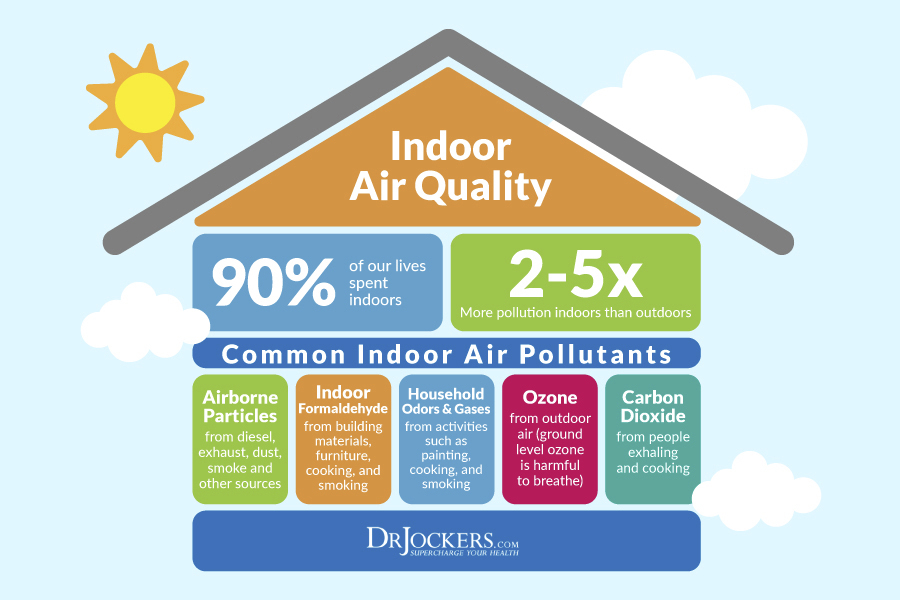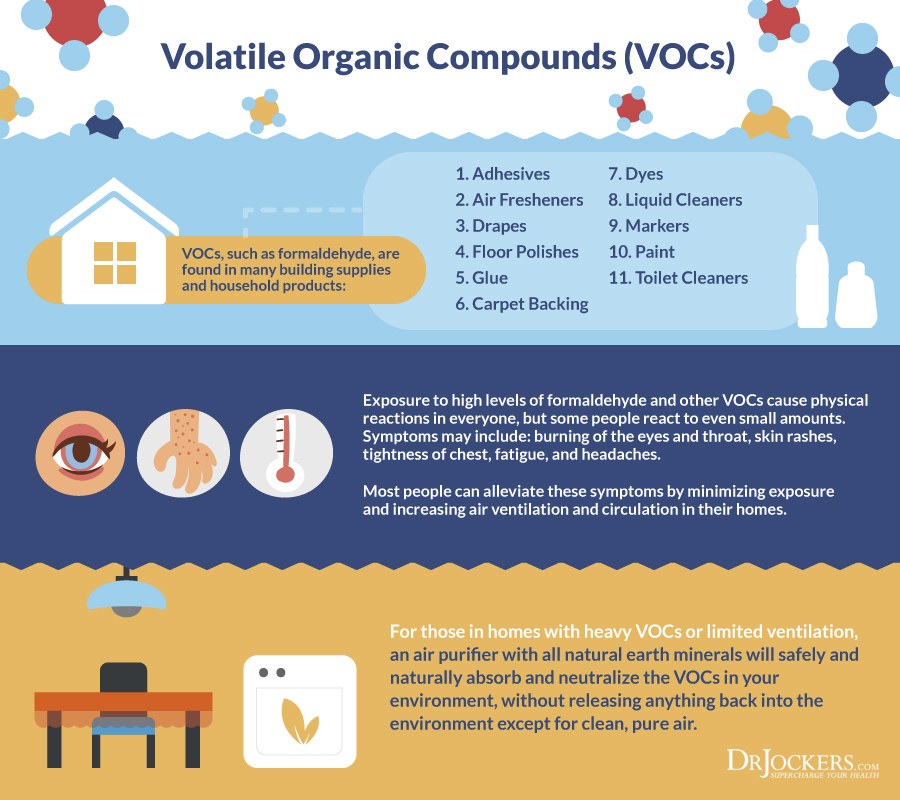 4 Ways to Improve Indoor Air Quality
4 Ways to Improve Indoor Air Quality
It is vital that we look to for ways to improve indoor air quality. A total of 10,000 liters of air enters your lungs every day, with the potential of breathing in harmful toxins being a very imminent threat to your health. The Global Burden of Disease (GBD) found that exposure to air pollution and particulate material was ranked as one of the top 10 risk factors for disease globally (1).
We tend to deem that air pollution is prominent in our outdoor environment due to high levels of chemicals produced in the environment by external factors such as cars and factories. Although, these factors do indeed produce a copious amount of chemicals, the environment that poses the biggest risk to you is undeniably your personal indoor environment. Finding ways to improve indoor air quality can be one of the biggest things you do for your health.

Toxic Chemicals in Our Home
Toxic chemicals can be in abundance in your home, without you even being aware. The U.S. Environmental Protection Agency (EPA) affirmed this by stating that indoor air is 2 to 5 times more polluted than outdoor air (2). Thus, discovering that indoor air is for the vast majority of people to be the unhealthiest air they breathe in during their day.
Chemicals are all around, surrounding you in the most inconspicuous of household items from your everyday laundry detergent to chemicals used on your furniture in the extensive manufacturing process. In recent years, a strong link between indoor air pollution and health related ailments has developed, therefore forming an undertaking to educate people on the impact indoor air pollution can have on your overall health.

Air Quality and Health
Indoor air quality has become a recent focus for many in the health profession, as research has shown a significant correlation to indoor air quality and certain health conditions such as respiratory, cardiovascular and autoimmune diseases. Air pollutants have several factors that impact their severity on your health including their size, shape, and the amount of time you are exposed to the pollutant (3).
Particulate matter can be a mixture of particles that can unfavorably affect somebody’s health, with the size of the particulate matter being the biggest determinant of causing possible health-related problems. To control particulate matter in your home, utilizing an effective HVAC filter for chemical odors and VOC removal can also help to remove not only particles from your indoor air but also bacteria from the environment. Particulate removal can aid drastically in improving your indoor air quality and helping to improve your overall health.

Health Effects of Indoor Air Pollution
Indoor air pollutants can impact your health and lead to negative health effects that can lead to severe symptoms and even disease. Air pollutants can affect certain areas of the body such as the respiratory system, immune system, skin and mucus membranes, cardiovascular system, liver, kidneys, and gastrointestinal (4).
The potential impact that indoor air pollution can have is cause for concern for many people. Keeping an eye out on possible symptoms stemming from indoor air pollution can help you to have a better understanding of when indoor air pollution is effecting your health. The symptoms to look out for include:

Ways to Improve Indoor Air Quality
Whatever is in your home’s air ends up in your body so finding ways to make it as clean as possible is the first step in shielding your health. Contaminant and toxins can be in the most unsuspecting places in your home, according to German chemist Michael Braungart he found that nearly everything we use, from our furniture to our cleaners, releases small particles or gases that are harmful to be ingesting on a regular basis (5).
Carpets, upholstery, wood products, and cleaning products can emit volatile organic compounds (VOCs) into your environment. You may be wondering how you can protect not only yourself but your home from these potentially dangerous chemicals. The steps below are to help you in the pursuit of improving your indoor air quality in your home.

Using Non-Toxic Cleaning Ingredients in Your House
Cleaning products can be a big contributor to indoor air pollution in your personal environment. To think that you are actually trying to help minimize dirt and pollutants in your home by cleaning. And then unknowingly contributing more pollutants in your environment, making your mission counterproductive.
Recent studies have connected cleaning sprays with asthma development, making the concern of cleaning supplies in your environment a possible fear. Most cleaning products contain terpene, hydrocarbons, terpene alcohols, and other related unsaturated compounds.
Natural Cleaning Products
These chemicals, specifically terpenes, can react with ozone to form a variation of secondary pollutants including formaldehyde and ultrafine particles (6). The pollutants that are then released into your air can be compromising the quality of the air in your home.
For many of us we have our go-to products that we always use during our cleaning process, but looking at the ingredients listed on your products can help you make better decisions when purchasing cleaning supplies in the future. I recommend switching to non-toxic, natural cleaning products to help you drastically increase the quality of the air in your personal environment, and help to minimize the potential release of added pollutants in your home.

Substitute Your Air Freshener for Essential Oils
Another major air pollutant that pollutes your home’s air quality can be air fresheners. Air fresheners, like other cleaning sprays, contain similar chemicals and thus have the same chemical reactions, producing secondary pollutants in the air of your home. These pollutants can have potentially serious health impacts including sensory irritation, respiratory symptoms, dysfunction of the lungs, and cause damage to the central nervous system (7).
Air fresheners over the past years has been deemed a source of various volatile organic compounds (VOCs) found in indoor environments which can be the leading source of these health impacts produced by air freshening products. So, how can you get rid of the odors that are stuck in your home without the use of air fresheners?
An ideal substitute in lieu of toxic air fresheners can be using essential oils in your home. Essential oils are natural organic compounds that are extracted from plants and contain a vast amount of healing properties. Using essential oils to freshen your personal environment rather than air fresheners will help you to avoid polluting your home’s air with harmful chemicals and airborne irritants.

Home Hygiene
Maintaining proper hygiene helps in the mitigation of bacteria and germs that collect on surfaces of your personal environment. Home hygiene isn’t necessarily the act of cleaning but more so a practice that should be implemented in your everyday routine. Without home hygiene, bacteria and viruses can begin to populate your indoor air and lead to the development of infectious diseases.
Recent studies have suggested that a promotion of improved hygiene in the home could have a significant impact in reducing infectious diseases (8). Wiping down surfaces can help in the effort to minimize bacteria and viruses in your home, as well as making sure you yourself are taking proper hygiene steps such as washing your hands frequently. By practicing good environmental hygiene practices and working towards eliminating bacteria and viruses at home you can help improve the overall air quality and your health long-term.
For a great natural all-purpose cleaner, try combining the following: 1/2 Cup vinegar, 5 cups of water, 5 drops each of wild orange, clove, lemon, tea tree, and rosemary. This can be used to naturally clean non-porous surfaces in the bathroom and kitchen.
Home Air Purifier
Air pollutants can be released from an abundance of surfaces and items in your home. In today’s homes, ventilation is very limited to help with lower cost utilities but with little ventilation leads to a trapping of pollutants in your home.
These pollutants can significantly impact your health and cause health related illnesses such as allergies, asthma, and respiratory diseases. Several allergists advocate air purifiers to their patients to help reduce health symptoms and increase the quality of air in the personal environment.
Dr. Daryl R. Altman, an allergist at the Joseph P. Addabbo Family Health Center in Queens, said purifiers are part of the mission against allergens like dust and pollen that affect your indoor air quality (9). Other doctors, also recommend air purifiers to help with the elimination of airborne allergens and pollutants, such as Dr. Nicolas Busaba, an ear, nose, and throat doctor at Harvard-affiliated Massachusetts Eye and Ear Infirmary (10). Dr. Busaba recommends an air purifier with a high efficiency particulate air (HEPA) filters to capture particles in the air.

EnviroKlenz Air Filtration System
The EnviroKlenz Mobile Air System utilizes not only a HEPA grade filter but also uses a two-stage filtration with their patented earth mineral technology. Effectively removing not only particulate matter in your indoor air environment but also toxins, chemicals, and strange odors in the air to improve the quality of the air you are breathing.
Toxins and chemicals in your indoor environment have the potential to be quite hazardous to your health. Implementing these methods to improve your personal environments indoor air quality can help you in the pursuit to aid in the betterment of your overall health.






Thanks for the info! Living in Los Angeles i surely appreciate any tips on keeping the air clean. Regarding the recommended air purifier, I went to their website when you posted this on Facebook and they were offering a 20% discount, presumably for those using your link. However, today when I go to make the purchase, the 20% discount is no longer there. Was that a one day deal?